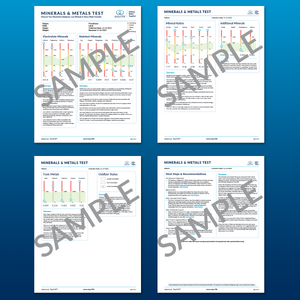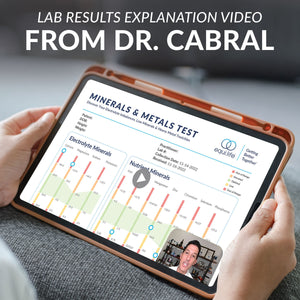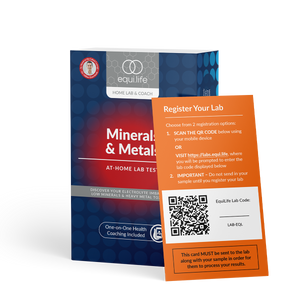



If you feel stressed, tired, anxious or overwhelmed it could be a sign your nervous system is strained. Minerals include electrolytes, which provide the energy you need to get through the day, as well as buffer the effects of stress. The Mineral & Metals Test takes a comprehensive look at adrenal function; the body's stress support system, as well as toxic metal exposure. If mineral reserves are low, electrolytes imbalanced or if you've been exposed to high levels of toxic metals you won't be able to deal with stress effectively and may experience a range of health challenges.
You will receive a video from Dr. Cabral that will provide you with a detailed explanation of how to understand your individual results.

The Mineral & Metals Test will give you clear insight into possible adrenal dysfunction as well as help you discover early warning signs of heavy metal toxicity by analyzing a hair sample. Minerals are key for overall good health and are often overlooked. In fact, imbalances of essential minerals like iron, magnesium and potassium can not only cause fatigue but could possibly be an indicator of more serious health issues over time. Toxins can't be avoided, and we are exposed to heavy metals in our daily environment. From the food you eat, air or water pollution, certain medicines, food containers with a harmful coating, personal care products we use on our skin and in our homes can all contain harmful chemicals and increase our toxic load. Arsenic, cadmium, lead and mercury are among four of the most common heavy metals that can cause health challenges. You will receive a video explanation of your lab results from Dr. Cabral and armed with a plan to restore mineral imbalances and remove accumulated toxicities, you'll be on the path to better manage stress, improve your energy levels, enjoy more restful sleep and a balanced mood.
Testing your essential mineral levels and potential toxic metal exposure can provide valuable insight into the underlying reasons why you feel overly stressed, anxious or overwhelmed, experience highs/lows in energy, skin rashes, headaches, poor sleep, mood disturbances or even learning difficulties in children. Taking a close look at iron, magnesium and potassium can help uncover the root causes of fatigue and poor stress management. In addition, assessing toxic heavy metal levels can identify if you have been exposed to high levels of mercury, cadmium, arsenic and aluminum that can cause a wide range of health related challenges. Hair testing reveals key information about your level of metabolic activity; unlike blood, hair is less susceptible to the homeostatic mechanisms that quickly affect trace element levels and long-term deviations of mineral retention or losses are more easily detected in hair. This Mineral & Metals Test will identify key mineral imbalances and assess your toxic metal exposure, providing pertinent information about metabolic rate, energy levels and stage of stress using a simple hair sample.
Calcium, Magnesium, Sodium, Potassium, Copper, Manganese, Zinc, Chromium, Selenium, Phosphorus, Iron
Essential minerals — those necessary for human health are classified into two equally important groups: major minerals and trace minerals.
The major minerals:are used and stored in large quantities in the body, are calcium, chloride, magnesium, phosphorus, potassium, sodium, and sulfur.
The trace minerals:just as vital to our health as the major minerals, but we don't need large amounts. Minerals in this category include chromium, copper, fluoride, iodine, iron, manganese, molybdenum, selenium, and zinc.
We don't manufacture essential minerals in the body and we get them from our diet. The minerals come from rocks, soil, and water, and they're absorbed as the plants grow or by animals as the animals eat the plants. When you eat a healthy diet that includes a variety of vegetables, beans, fruits, whole grains, lean protein, and unsaturated fats (like olive oil), you're likely consuming all the healthy minerals you need.
Essential minerals (metals are also one type of mineral):
Minerals and also electrolytes tested:
Electrolyte Balance:
Lead, Mercury, Cadmium, Arsenic, and Aluminum
Our health and wellbeing may be challenged by mineral imbalances and toxic metal excesses, aggravating conditions including cardiovascular disease, high cholesterol, high blood pressure, migraines, learning difficulties and hyperactivity in children.
Toxic metals can impair thyroid function and can prevent calcium from getting into bone, brain fog, and skin rashes.
Heavy Metal Toxins Tested:
Individual levels need to be optimal as well as in the correct ratio.
Help determine carbohydrate metabolism, thyroid function, levels of inflammation, adrenal reserves, copper toxicity, tissue breakdown and calcium shell.
Ca/Mg
Ca/K
Na/K
Zn/Cu
Ca/P
Nickel, Cobalt, Molybdenum and Lithium
Nickel (Ni): Most absorbed nickel is of dietary origin from hydrogenated oils, cocoa and chocolate. Batteries (nickel-cadmium), non-precious dental materials, costume jewelry, and nickel-plated hardware are other sources that may be of concern in nickel dermatitis. Smoke, cigarette smoking and food are major sources of nickel exposure.
Metabolism Measure: Mixed, slow or fast Oxidizer using the Ca/K (thyroid) and Na/Mg (adrenal) ratio
Analysis of mineral status and ratios found in hair can reveal the general rate of metabolic function.
The metabolism of carbohydrates, proteins and fats into energy is referred to as oxidation. This is the rate at which nutrients are converted to energy within all of your body's cells. If oxidation occurs too slowly or too fast, energy production is impaired. Your oxidation rate is influenced by both your genetics and diet. Therefore, what you eat affects your rate of oxidation and energy production, which in turn affects your mental, emotional, behavioral, and in most cases, physical health.
Determining if you are a fast or slow oxidizer can help you alter your lifestyle, most particularly your diet, to support your metabolism. If we are eating food that does not burn efficiently based on the needs of our body we will not function optimally, and this can lead to not only physical but also mental health challenges.
People can be divided into three general body types:
EquiLife labs are designed to provide detailed and thorough information so that you can understand your health at the deepest level, allowing you to finally get to the root cause of your biggest health concerns.
Testing takes the guesswork out of your health and empowers you to make informed choices about your health. Along with your lab results will be a video by Dr. Cabral which provides you with a detailed explanation.
To ensure you feel confident about your lab findings, at your request EquiLife offers 1-on-1 Health Coaching Support to review your results with you and answer any questions you may have.
Get to the Root Cause
Once you receive your at-home lab test, please follow the instructions provided to register your test. Once sample(s) are sent to one of our CLIA certified labs, it will take approximately 3 weeks for your results to be returned, during which time you will receive a video explanation of your lab results from Dr. Cabral.
All at-home lab tests expire 6-months from their purchase date. To ensure you will receive your results, please be sure to send all samples for completed lab tests prior to the 6-month expiration date. Unfortunately, there can be no returns or replacement lab tests sent after the 6-month time frame.
Please remember to register your labs prior to sending your sample to the laboratory.
We have compiled thorough FAQs for our at-home lab tests, which you can browse here:
https://faq.equi.life/en-US/articles/lab-kit-faq-14490.
For additional questions, you can contact us at support@equi.life.



